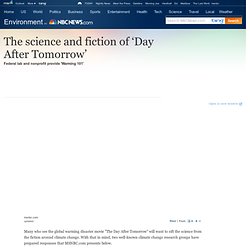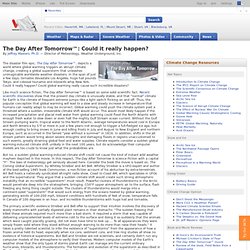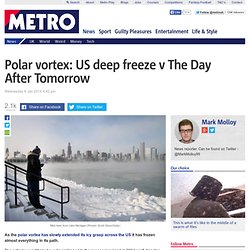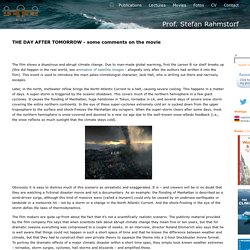

The Science of Abrupt Climate Change. Introduction We generally consider climate changes as taking place on the scale of hundreds or even thousands of years.

However, since the early 1990s, a radical shift in the scientific understanding of Earth's climate history has occurred. We now know that that major regional and global climate shifts have occurred in just a few decades or even a single year. The most recent of these shifts occurred just 8200 years ago. If an abrupt climate change of similar magnitude happened today, it would have severe consequences for humans and natural ecosystems. 小冰河期的成因之一,歷史上新仙女木期的可能發生原因之一~~溫鹽環流受阻~! The Day After Tomorrow - Good and Bad Science in the Movie. The Day After Tomorrow Good and Bad Science as Presented in the Movie Introduction and Background Information Global Warming is a familiar topic that shows up frequently news headlines, is taught in science classes and explored in depth in science magazines.

Documented scientific evidence exists that earth is warming and that, in fact, it has warmed 1° Fahrenheit (0.56° Celsius) in the last decade, mostly due to an increase in atmospheric carbon dioxide caused by the burning of fossil fuels. While one degree may not seem all that significant the fact is that such an increase has had an impact on global sea levels due to the melting of Arctic, Antarctic and Greenland Ice. If global temperatures continue to increase many or all of the following concerns can and will become a reality: Malnutrition Heat stress Widespread disease. Science and fiction of 'Day After Tomorrow' - US news - Environment. Many who see the global warming disaster movie "The Day After Tomorrow" will want to sift the science from the fiction around climate change.

With that in mind, two well-known climate change research groups have prepared responses that MSNBC.com presents below. The National Center for Atmospheric Research, a federal lab, looks at three of the movie's key scenarios. The Pew Center for Climate Change, a nonprofit alliance of major businesses seeking strategies to counter warming, answers some commonly asked questions via its director, Eileen Claussen, who previously has held senior science policy positions at the State Department and National Security Council. The responses are followed by a list of online resources on climate change. NCAR's response Movie scenario. Movie scenario. Movie scenario. Science Fiction. Click to read the Executive Summary Read the Sidebar: Live Earth: NBC Joins the Fight for 'Climate in Crisis,' Fails to Stay Objective Baaaa-dum.

It only took two musical notes to set the mood and terrify viewers watching the movie "Jaws" in 1975. Today it only takes two words: global warming. Global warming, or climate change due to a phantom menace called carbon dioxide, is more frightening to many than aliens, evil robots and mad scientists. On May 24, it will have been five years since "movie star" Gore tried to scare the world into making massive societal changes with his error-filled documentary, "An Inconvenient Truth. " Gore, the "darling of Hollywood" and a "full-time environmentalist" according to network reporters, turned global warming fearmongering into a Hollywood hit, making nearly $50 million worldwide, according to BoxOfficeMojo.
Apocalypse Al Gets Network Attention, But His Faulty Science Gets Little Criticism But once Gore replied, "There's really not a debate. Charles S. The Day After Tomorrow: Could it Really Happen? Resources:

The Day After Tomorrow Reviews. The Day After Tomorrow movie mistakes, goofs and bloopers. The Day After Tomorrow. The disaster film epic, The Day After Tomorrow™, depicts a world where global warming triggers an abrupt climate change, creating a global superstorm that unleashes unimaginable worldwide weather disasters.

In the span of just a few days, tornados devastate Los Angeles, huge hail pounds Tokyo, and colossal tsunamis and blizzards whip New York. Could it really happen? Could global warming really cause such incredible disasters? Polar vortex: US deep freeze v The Day After Tomorrow. As the polar vortex has slowly extended its icy grasp across the US it has frozen almost everything in its path.

The extreme conditions have been likened to the scenes imagined in 2004 sci-fi disaster film The Day After Tomorrow. We compare how the current Arctic blast compares to the catastrophic climatic effects seen in the Hollywood blockbuster below. 1. Frozen cities NEW hi-res pic of an icy, cold #Chicago [courtesy my pilot friend Hank Cain]. 2. 3. 4. 5. The film "The Day After Tomorrow" - comments by climatologist Stefan Rahmstorf. The film shows a disastrous and abrupt climate change.

Due to man-made global warming, first the Larsen B ice shelf breaks up (this did happen in the real world, see animation of satellite images - allegedly only after the authors had written it into the film). This event is used to introduce the main paleo-climatologist character, Jack Hall, who is drilling out there and narrowly escapes. Later, in the north, meltwater inflow brings the North Atlantic Current to a halt, causing severe cooling. This happens in a matter of days. A super-storm is triggered by the oceanic shutdown. Obviously it is easy to dismiss much of this scenario as unrealistic and exaggerated.
The Day After Tomorrow.